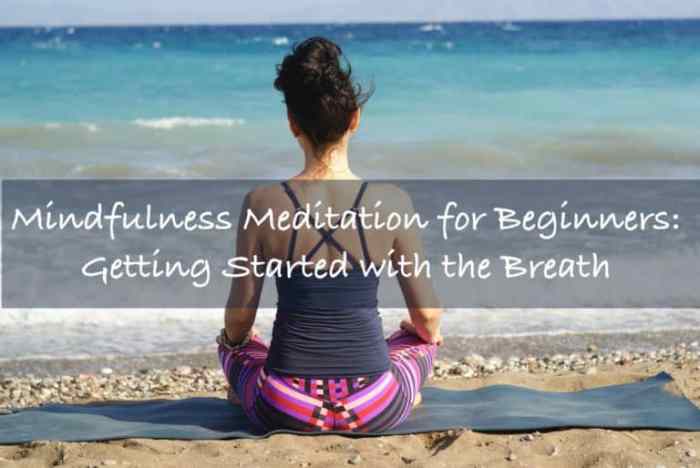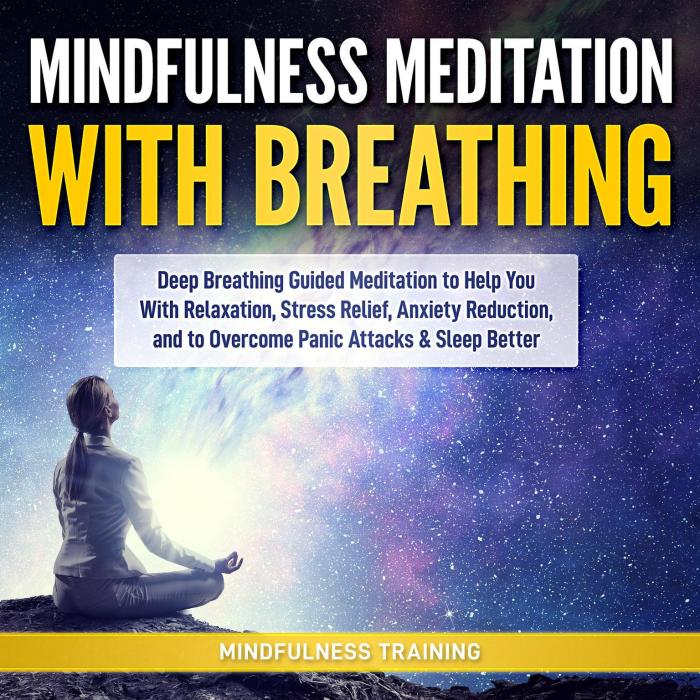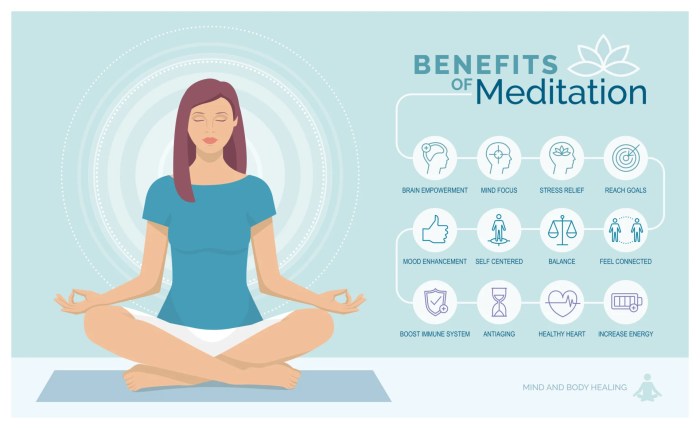6 Guided Meditation Practices for Mindful Awareness introduces a journey towards enhancing mindfulness through various meditation techniques, offering a transformative experience for individuals seeking mental clarity and inner peace.
Delve into the realm of guided meditation, body scan meditation, loving-kindness meditation, mindful breathing meditation, visualization meditation, and walking meditation to cultivate a deeper sense of self-awareness and well-being.
Introduction to Guided Meditation
Guided meditation is a form of meditation where an individual is led through a specific meditation practice by a trained guide or teacher. This can be done in person, through recordings, or online platforms. It helps individuals focus their mind and attention, making it easier to relax and enter a meditative state.
Concept of Mindful Awareness in Meditation
Mindful awareness in meditation involves being fully present in the moment, observing thoughts and feelings without judgment. It encourages a non-reactive awareness of the present moment, helping individuals to cultivate a sense of calm and clarity in their minds. This practice helps individuals to develop a greater sense of self-awareness and emotional regulation.
Benefits of Incorporating Guided Meditation Practices
- Reduces stress and anxiety: Guided meditation can help individuals relax and reduce stress levels, promoting a sense of calm and well-being.
- Improves focus and concentration: By guiding the mind through a specific practice, guided meditation can enhance focus and concentration levels.
- Promotes emotional well-being: Mindful awareness in meditation can help individuals process their emotions in a healthier way, leading to improved emotional well-being.
- Enhances self-awareness: Guided meditation practices can increase self-awareness and help individuals better understand their thoughts and feelings.
- Encourages better sleep: By promoting relaxation and reducing stress, guided meditation practices can help individuals improve their quality of sleep.
Body Scan Meditation

Body scan meditation is a mindfulness practice that involves focusing your attention on different parts of your body, from head to toe, in a systematic way. This practice helps you become more aware of physical sensations, thoughts, and emotions, promoting a deep sense of relaxation and presence.
Steps to Practice Body Scan Meditation:
- Find a quiet and comfortable place to sit or lie down.
- Close your eyes and start by taking a few deep breaths to relax.
- Begin to slowly scan your body from head to toe, paying attention to any sensations you notice along the way.
- As you focus on each body part, try to release any tension or tightness you may feel by breathing into that area.
- Continue scanning your body, moving your attention from one body part to the next, without judgment or analysis.
- Finish the practice by taking a few more deep breaths and slowly opening your eyes.
Potential Benefits of Regularly Practicing Body Scan Meditation:
- Improves body awareness and connection
- Reduces stress, anxiety, and muscle tension
- Promotes relaxation and better sleep quality
- Enhances mindfulness and presence in daily life
- Helps in recognizing and releasing physical and emotional blockages
Loving-Kindness Meditation

Loving-Kindness Meditation, also known as Metta Bhavana, is a practice that involves directing positive energy, love, and compassion towards oneself and others. It cultivates feelings of goodwill, empathy, and kindness towards all beings, including those you may have difficulties with. The practice aims to increase feelings of interconnectedness and reduce negative emotions such as anger, resentment, and judgment.
Principles of Loving-Kindness Meditation
Loving-kindness meditation is based on the principles of compassion, empathy, and forgiveness. It involves offering loving-kindness to oneself, loved ones, neutral individuals, difficult individuals, and eventually to all beings. The practice emphasizes the belief that all individuals deserve happiness and freedom from suffering, regardless of their actions or circumstances.
- Start by focusing on yourself and repeating phrases such as:
“May I be happy. May I be healthy. May I be safe. May I live with ease.”
- Extend loving-kindness to loved ones by visualizing them and repeating phrases like:
“May you be happy. May you be healthy. May you be safe. May you live with ease.”
- Move on to neutral individuals, difficult individuals, and eventually to all beings, repeating the same phrases while cultivating feelings of love and compassion.
Impact of Loving-Kindness Meditation on Mental Well-Being, 6 Guided Meditation Practices for Mindful Awareness
Loving-kindness meditation has been shown to have numerous benefits for mental well-being. Research suggests that regular practice can lead to increased positive emotions, reduced symptoms of depression and anxiety, improved empathy and compassion towards others, and enhanced overall life satisfaction. The practice can also help in developing a more positive outlook on life and fostering healthier relationships with oneself and others.
- Studies have shown that loving-kindness meditation can increase feelings of social connection and decrease feelings of isolation and loneliness.
- Practicing loving-kindness can also lead to greater emotional regulation, allowing individuals to respond to challenging situations with more patience and understanding.
Mindful Breathing Meditation
Practicing mindful breathing meditation involves focusing on the breath as a way to cultivate awareness and reduce stress. By paying attention to the inhalation and exhalation of each breath, individuals can anchor themselves in the present moment and develop a deeper sense of self-awareness.
Significance of Mindful Breathing
- Mindful breathing helps to bring attention to the present moment, promoting a state of mindfulness.
- It allows individuals to observe their thoughts and emotions without judgment, leading to increased self-awareness.
- By focusing on the breath, one can calm the mind, reduce stress, and improve overall well-being.
Techniques for Focusing on the Breath
- Begin by finding a comfortable seated position and bringing attention to the natural rhythm of your breath.
- Notice the sensation of the breath entering and leaving your body, focusing on the rise and fall of your chest or the feeling of air passing through your nostrils.
- If your mind starts to wander, gently guide your attention back to the breath without judgment.
- Some people find it helpful to count their breaths or use a mantra to maintain focus.
Enhancing Self-Awareness and Reducing Stress
- Regular practice of mindful breathing meditation can help individuals become more attuned to their thoughts, feelings, and bodily sensations.
- As self-awareness grows, individuals may notice patterns of behavior or triggers for stress, allowing for more conscious responses.
- By cultivating a sense of presence through mindful breathing, individuals can better manage stress and improve their overall emotional well-being.
Visualization Meditation

Visualization meditation involves creating mental images or scenarios in the mind to help focus and calm the thoughts. This form of meditation differs from other practices as it relies on the power of imagination to evoke feelings of relaxation and positivity.
Guided Imagery Techniques
- Begin by finding a quiet and comfortable space to sit or lie down.
- Close your eyes and take a few deep breaths to relax your body and mind.
- Imagine a peaceful place, such as a beach or a forest, and visualize yourself there in detail.
- Engage all your senses by imagining the sights, sounds, smells, and even the sensations of this place.
- Focus on positive emotions like joy, love, and gratitude as you immerse yourself in this visualization.
- Stay in this mental space for a few minutes, allowing yourself to fully experience the calming effects of the visualization.
Benefits of Visualization Meditation
- Enhanced relaxation and stress reduction: Visualization helps to shift focus away from negative thoughts and promote a sense of calm.
- Improved focus and concentration: By practicing visualization regularly, you can train your mind to concentrate better on tasks at hand.
- Increased positivity and optimism: Visualizing positive scenarios can help cultivate a more optimistic outlook on life.
- Emotional healing and self-compassion: Visualization can be a powerful tool for processing emotions and fostering self-love and compassion.
- Boosted creativity and problem-solving skills: Engaging in creative visualizations can stimulate innovative thinking and problem-solving abilities.
Walking Meditation

Walking meditation is a mindfulness practice that involves focusing on the present moment while walking. Originating from the Buddhist tradition, walking meditation is a way to cultivate awareness, calmness, and concentration through movement.
Engaging in Walking Meditation Mindfully
- Find a quiet and safe place to walk, preferably outdoors to connect with nature.
- Start by standing still and bringing attention to your breath, grounding yourself in the present moment.
- Begin walking at a slow and deliberate pace, paying attention to each step you take.
- Focus on the sensations in your body as you walk, from the movement of your legs to the feeling of the ground beneath your feet.
- Acknowledge any thoughts or distractions that arise, but gently guide your awareness back to the act of walking.
- Continue walking for a set period of time, maintaining a sense of mindfulness and presence throughout the practice.
Benefits of Combining Movement with Meditation
Walking meditation offers a unique way to integrate mindfulness into daily life by combining physical activity with mental focus. The benefits of walking meditation include:
- Improved concentration and focus
- Reduced stress and anxiety levels
- Enhanced mind-body connection
- Increased sense of calm and relaxation
- Opportunity for self-reflection and introspection
Final Review: 6 Guided Meditation Practices For Mindful Awareness

Embark on a path of self-discovery and tranquility with these 6 Guided Meditation Practices for Mindful Awareness, enriching your daily life with mindfulness and inner balance. Start your journey today and unlock the profound benefits of a mindful meditation practice.